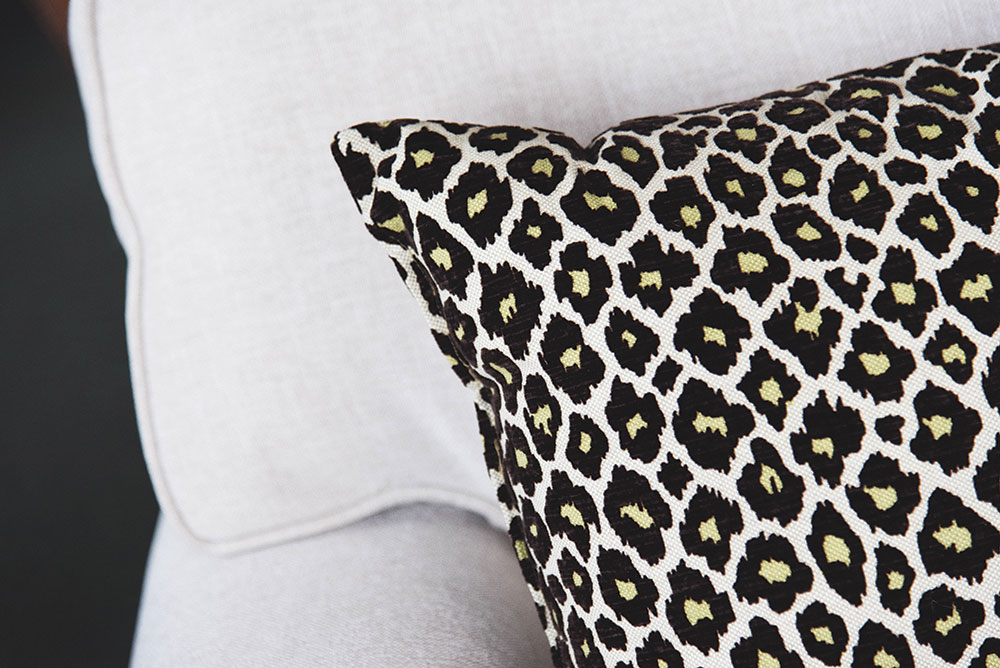
Joe Deaton used to blast mines for a living. Work doesn’t get much more straightforward than that — so when he took up his latest profession, tailoring custom textiles, it happened in the frankest way possible: he saw a problem, and became the solution.
The husband and business partner of interior designer Harrietta “Harry” Deaton, Joe is himself a uniquely talented maker. He fabricates the firm’s design projects large and small, from pillow shams to grand-scale window treatments.
The Deatons’ retail store carries a dozen high-quality fabric lines, including Kravet and Lee Jofa, as well as a seemingly limitless library of textiles and wallpapers. In addition to their services, the firm smartly fills an expansive retail space on Hendersonville’s South King Street.
“But he won’t let me into his studio,” says Harry, laughing. Indeed, sewing is serious business for Joe. “He’s a big guy, you know, so it’s a surprise that he’s so meticulous.”
After 38 years of marriage, Joe and Harry maintain a solid partnership based on a reverence for good design, an obsession for details, and a clearly exhibited affection for their clients, including many repeaters.
You’re doing work that’s traditionally considered women’s work. Do clients often register surprise when they learn who’s doing the sewing?
Oh, yes. They don’t expect a man to be making pillows and dust ruffles. I guess it’s the reverse [of what’s expected of women doing men’s jobs]: I must prove to them I’m just as good as any professional seamstress.
Why did you learn?
We used to sub our sewing work out to folks who would tell us something would be ready in two weeks, but then it wouldn’t be — and we’d have to tell our customers the bad news. Understandably, they’d be unhappy. We tried to solve that problem by starting our own work room, buying the right equipment, and hiring seamstresses to work in-house, so we’d have more control over projects and deadlines. But we ran into the same problem — [workers who weren’t] available, and projects still not ready on time.
That must have been frustrating, not to be able to control that piece of your business which so affects the bottom line — and your reputation.
That’s right. But I started watching these seamstresses as they worked and I learned everything I could — all the different stitches — and started trying to do what they did. Things like the pattern repeat on fabric [including calculating yardage according to the size of the print] really made it challenging, but I believe you can learn anything if you put enough effort into it. I learned these skills and always say I’ve been peddling in fabrics for 10 years, and doing all our custom shop work for about seven.

Let’s peek behind the curtain, so to speak … what else do you make?
I also do custom bedding — bedspreads, pillow shams, bed skirts. I make accent pillows, tablecloths, draperies, and many types of window treatments, like cornice boards. There are also lots of ways you can hang curtains, depending on the rod. I do loops, pinch pleats, rod pockets, strings, and ring ties.
Textiles seem easily as important as paint color in creating mood for a space, since they cover everything from floors to furniture. Yet it seems paint gets all the attention.
Exactly — fabric’s an easy way to add color, it makes a big statement in a room, and it’s budget-friendly. If you have pretty curtains and you take them down, your house looks emptier, colder. Curtains make a room warm and cozy; they even soften sound. Window treatments are a house’s “eye candy.”
You’re also a proponent of recycling textiles creatively.
Yes. Our repeat customers bring us their curtains when they move to a new house — they’ll reuse the curtains but I’ll alter them to fit their new windows and add details, like fringe or tassels. Curtain sewing is similar to building a house: you need to get your measurements, cut everything square, and go from there.
What’s your favorite type of sewing project?
I love doing curtains with rings on them and making duvet covers — putting a job together through installation brings a sense of real accomplishment.
What are your favorite fabrics to work with?
Velvet’s easy to work with and looks great; linen’s another because it hangs so well, and silk, in the right application, is wonderful.
Do you ever encourage hesitant customers to use a color or pattern you know will be gorgeous, but they’re afraid to take the leap?
Harry does a lot of that, and they rarely regret going with a rich color or bold design, but we encourage them to take samples home and live with them a bit, see how light affects them, etc. We regularly get cards from clients saying they’re happy we nudged them.
Does it ever get stressful when you’re both creatively and matrimonially connected?
Joe: We have our disagreements occasionally, but …
Harry: … but I usually win. And I still don’t have curtains!
Harry Deaton Interiors is located at 419 South King St. in Hendersonville. For more information, call 423-972-1035 or see harrydeatoninteriors.com
